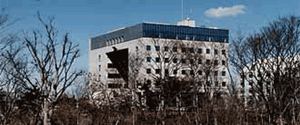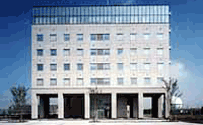| Its predecessor was a lodge for research, called Asahi Hut, built on Mt.Norikura based on an Asahi Academic Grant. In 1953, it was transformed into the Cosmic Ray Observatory of The University of Tokyo. This observatory was Japan's first research facility for nationwide joint use. In 1957, it participated in worldwide observations of the International Geophysical Year (IGY), pioneering international activities. In the same year, it embarked on the observations of air showers, and in 1958, it started using an emulsion chamber for observations. Since then, the observatory has continued steady observations with these instruments.
In 1972, the construction of Mutron (electromagnetic spectrometer) was commenced, improving the facilities for experiments. In 1973, two international projects of the Japan Society for the Promotion of Science were incorporated into the research of this institute. One project was a deep underground experiment at Kolar Gold Mine in India, and the other was a high-altitude experiment on Mt.Chacaltaya in Bolivia. In 1975, the Mutron was completed, and then the construction of Akeno Observatory was started.
In 1976, the Cosmic Ray Observatory was reorganized into the Institute for Cosmic Ray Research (ICRR). ICRR absorbed the 3 sections of the Cosmic Ray Division of the Institute for Nuclear Study, The University of Tokyo, which had conducted similar research since 1956, and started its research projects over again as an institute composed of 6 divisions and 1 facility. In 1977, the Akeno Observatory was formally recognized as a second attached facility. In 1979, a 1 km2 air-shower detector, which was installed in the Akeno Observatory, and an emulsion chamber, which was placed on Mt.Fuji, were developed. In 1981, Japan-China joint research was initiated using the emulsion chamber. In 1983, a proton decay experiment was started as a joint experiment in Kamioka, and the construction of facilities for studying primary cosmic rays was finished.
From 1985, ICRR increasingly produced significant experimental results, and further improved its experimental equipment. In 1987, the Kamioka Observatory succeeded to trap neutrinos from a supernova for the first time in the world. In the same year, the construction of a 100 km2 wide-area air-shower detector was commenced at Akeno Observatory. In 1988, the Kamioka Observatory observed a deficit of solar neutrinos, and in 1989, the Norikura observatory observed a considerable increase in cosmic neutrons in the wake of a solar flare. In 1990, the construction of the wide-area air-shower detector at the Akeno Observatory was finished. In 1991, the construction of Super-Kamiokande was started. In 1992, a collaborative research team in Australia observed ultra-high-energy gamma rays for the first time in the southern hemisphere. In the same year, a new team for observing gravitational waves joined ICRR. In 1993, the construction of the air-shower gamma-ray detector was started in Tibet. In 1994, the Akeno Observatory observed a big shower, whose energy level was beyond the theoretical limit, and the Kamioka Observatory detected an anomaly in atmospheric neutrinos. In 1995, the Kamioka Observatory restarted its research as the third attached facility. In 1996, Super-Kamiokande was completed, and initiated full-scale observation. In 1998, the Super-Kamiokande team reported, as a finding of a two-year observation, that a neutrino has mass.
In 1999, in order to further study the mass of neutrinos, ICRR started an experiment to detect artificial neutrinos that are emitted from the High Energy Accelerator Research Organization at Super-Kamiokande. The Research Center for Cosmic Neutrinos was also established for collecting information on the observation of cosmic neutrinos, and paving the way for new neutrino research. Moreover, ICRR was granted a Scientific Research Fund for a COE (Center of Excellence), which was used for significantly improving the ultra-high-energy gamma-ray observations in Australia. In 2003, ICRR was granted a Scientific Research Fund to investigate the origin of extremely high-energy cosmic rays for the Telescope Array (TA) experiment. After five years construction, TA observation started in 2008.
On April 1, 2004, The University of Tokyo became an independent administrative entity, and ICRR's research divisions were reformed to establish a research system composed of 3 research divisions.
On April 1, 2010, ICRR renewed its inter-university research activities as a new "Inter-University Research Center".
In July 2010, the Large Cryogenic Gravitational wave Telescope (LCGT) project (later named "KAGRA") was approved by the "Leading-edge Research Infrastructure Program" of MEXT. The construction of LCGT has started in the same year. Gravitational Wave Project Office was formed in ICRR on April1, 2011 for the construction of LCGT.
In 2010, T2K, or Tokai to Kamioka Long Baseline Neutrino Oscillation Experiment, started its operation, and in June 2011 found an indication of a new type of neutrino oscillation from a muon neutrino to an electron neutrino. The data from T2K show clear evidence for muon-neutrino to electron neutrino oscillations by 2014.
In March 2012, very high-energy gamma-ray observatory in Australia, the CANGAROO experiment, ended its operation. The gamma-ray studies will be taken over by the CTA (Cherenkov Telescope Array) project. The first Large Size Telescope (LST) of CTA will be constructed in 2015-2016 at La Palma in Canary Islands.
|



